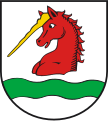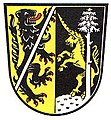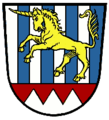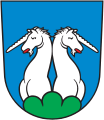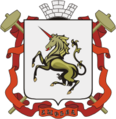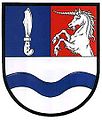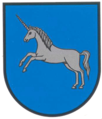Unicorn (heraldic animal)

The unicorn or monoceros is a mythical animal . In heraldry , it is a heraldic animal .
Thus it is a common figure and is subject to the general heraldic rules for the representation in the coat of arms, also in the tinging , as it applies to heraldic animals and common figures.
Representation and symbolism
It is depicted as a wild, unbridled and bareback animal in the shape of a horse, which carries a straight, pointed, twisted horn on the middle of its forehead as a powerful and dangerous weapon. The hooves are often shown split as in the case of an even-toed ungulate , the tail resembles a cow or lion tail. The horn in old heraldic representations was curved, in more recent heraldry it is straight.
Belief in this animal is very old and common. Aristotle and Pliny report a lot about such an animal without, of course, ever having seen one. India and Africa were adopted as living space. The tusk of the narwhal was often shown in collections as the horn of the animal, from which many legends about unicorns may have originated.
In the Christian world it has become the symbol of Christ and stands for the purity and virginity of Mary. The unicorn has found its way into heraldry as a symbol of royal justice.
As a heraldic animal in heraldry , it is usually shown rising or erect with a view to the right; Horn, hooves, tongue, but also the mane are tinged differently by the animal. The white (silver) color for the body is predominant. It is found less often in the coat of arms, more often in the upper coat of arms and as a popular shield holder . Basic forms of representation are the whole animal rising , only the head and, as growing up, the front part. Unicorns with fish tails are less common.
Examples
In the coat of arms of the United Kingdom , the unicorn is a shield holder next to the lion , both with a crown (crowned), it symbolizes Scotland . In the Canadian coat of arms there is a unicorn as a shield holder on the left, which holds the banner with the two French letters placed over one in blue. Holding lilies. It is represented there with a long chain on the collar (chained unicorn).
According to the nobility letter of 1793 from Emperor Franz II, it is also a shield holder. In Friedrich Schiller's coat of arms it is growing up in the field and in the upper coat of arms . Also Parish of Senftenberg performed it even with three heads in the arms. A family shield with a unicorn is known from Count Kolowrat, which he later adopted in his coat of arms as Archbishop of Prague (1830–1833). The Russian city of Lyswa took over the unicorn from the coat of arms of the Shuvalovs , who owned the iron foundry there in the 19th century .
Coat of arms of Korbersdorf, part of Marktredwitz , Bavaria
Coat of arms of Lichtenberg , Bavaria
Coat of arms of Opfenbach , Bavaria
Coat of arms of the former district of Höchstadt an der Aisch , Bavaria
Coat of arms of the former district of Scheinfeld , Bavaria
Coat of arms of Giengen an der Brenz , Baden-Württemberg
Coat of arms of Oberried , Baden-Württemberg
Coat of arms of Tengen , Baden-Wuerttemberg
Coat of arms of the district Wiechs am Randen
Coat of arms of Heeren-Werve , part of Kamen, North Rhine-Westphalia
Coat of arms of Leeden , North Rhine-Westphalia
Coat of arms of Mils near Hall , Tyrol
Coat of arms of Seefeld , Tyrol
Coat of arms of Perg , Upper Austria
Bludenz coat of arms , Vorarlberg
Coat of arms of Hünenberg , Canton of Zug
Coat of arms of Dübendorf , Canton of Zurich
Wapen from Ramosch , Canton of Graubünden
Coat of arms of Saint-Lô , Normandy
Winged in the arms of Brailly-Cornehotte , Hauts-de-France
Coat of arms of Wądroże Wielkie , Powiat Jaworski, Poland (unicorns as fish-tailed shield holders)
Coat of arms of Vyksa , Nizhny Novgorod region, Russia
Coat of arms of Lyswa , Perm Region, Russia
Coat of arms of Prasklice , Czech Republic
Coat of arms of Vážany nad Litavou , Czech Republic
Coat of arms of Nemyriv , Ukraine
Coat of arms of Aszód , Hungary
Unicorn is sign holder in Kazincbarcika , Hungary
Coat of arms of Lengyeltóti , Hungary
See also
literature
- Milan boys : heraldry. Edited edition. Albatros, Prague 1987.
- Hans-Ulrich Herzog: Flags and coats of arms (= BI pocket dictionary ). VEB Bibliographisches Institut, Leipzig 1980.
- Gert Oswald : Lexicon of Heraldry. VEB Bibliographisches Institut, Leipzig 1984.
Individual evidence
- ^ Walter Leonhard : The great book of heraldic art. Development, elements, motifs, design. 2nd, revised and expanded edition. Georg DW Callway, Munich 1978, ISBN 3-7667-0345-5 .
- ^ Scottish fact of the week: Scotland's official animal, the Unicorn . Retrieved September 17, 2014.




